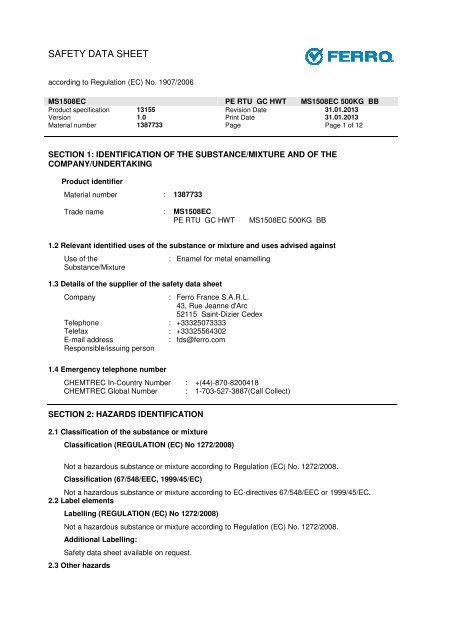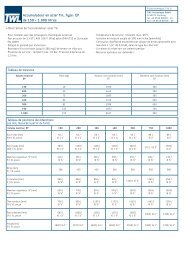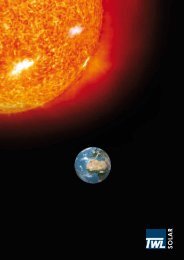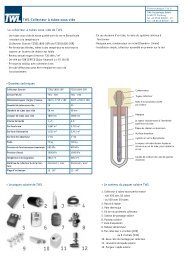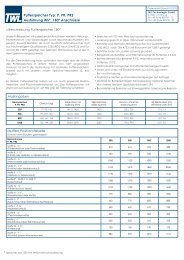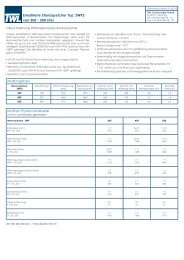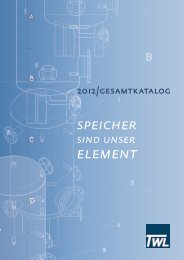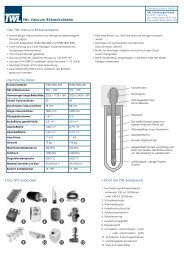SAFETY DATA SHEET - TWL-Technologie GmbH
SAFETY DATA SHEET - TWL-Technologie GmbH
SAFETY DATA SHEET - TWL-Technologie GmbH
You also want an ePaper? Increase the reach of your titles
YUMPU automatically turns print PDFs into web optimized ePapers that Google loves.
<strong>SAFETY</strong> <strong>DATA</strong> <strong>SHEET</strong><br />
according to Regulation (EC) No. 1907/2006<br />
MS1508EC PE RTU GC HWT MS1508EC 500KG BB<br />
Product specification 13155 Revision Date 31.01.2013<br />
Version 1.0 Print Date 31.01.2013<br />
Material number 1387733 Page Page 1 of 12<br />
SECTION 1: IDENTIFICATION OF THE SUBSTANCE/MIXTURE AND OF THE<br />
COMPANY/UNDERTAKING<br />
Product identifier<br />
Material number : 1387733<br />
Trade name<br />
: MS1508EC<br />
PE RTU GC HWT<br />
MS1508EC 500KG BB<br />
1.2 Relevant identified uses of the substance or mixture and uses advised against<br />
Use of the<br />
Substance/Mixture<br />
: Enamel for metal enamelling<br />
1.3 Details of the supplier of the safety data sheet<br />
Company<br />
: Ferro France S.A.R.L.<br />
43, Rue Jeanne d'Arc<br />
52115 Saint-Dizier Cedex<br />
Telephone : +33325073333<br />
Telefax : +33325564302<br />
E-mail address<br />
: fds@ferro.com<br />
Responsible/issuing person<br />
1.4 Emergency telephone number<br />
CHEMTREC In-Country Number : +(44)-870-8200418<br />
CHEMTREC Global Number : 1-703-527-3887(Call Collect)<br />
SECTION 2: HAZARDS IDENTIFICATION<br />
2.1 Classification of the substance or mixture<br />
Classification (REGULATION (EC) No 1272/2008)<br />
Not a hazardous substance or mixture according to Regulation (EC) No. 1272/2008.<br />
Classification (67/548/EEC, 1999/45/EC)<br />
Not a hazardous substance or mixture according to EC-directives 67/548/EEC or 1999/45/EC.<br />
2.2 Label elements<br />
Labelling (REGULATION (EC) No 1272/2008)<br />
Not a hazardous substance or mixture according to Regulation (EC) No. 1272/2008.<br />
Additional Labelling:<br />
Safety data sheet available on request.<br />
2.3 Other hazards
<strong>SAFETY</strong> <strong>DATA</strong> <strong>SHEET</strong><br />
according to Regulation (EC) No. 1907/2006<br />
MS1508EC PE RTU GC HWT MS1508EC 500KG BB<br />
Product specification 13155 Revision Date 31.01.2013<br />
Version 1.0 Print Date 31.01.2013<br />
Material number 1387733 Page Page 2 of 12<br />
Prolonged inhalation of fine quartz dust may cause silicosis when the maximum admissible<br />
concentration at the work place is exceeded. Symptoms of a silicosis may be cough and chronic<br />
inflammation of the respiratory system. There is some evidence of an increased lung cancer risk to<br />
people already suffering from silicosis.<br />
SECTION 3: COMPOSITION/INFORMATION ON INGREDIENTS<br />
3.2 Mixtures<br />
Hazardous components<br />
Chemical Name CAS-No.<br />
EC-No.<br />
Registration<br />
number<br />
borax pentahydrate 12179-04-3<br />
/<br />
sodium nitrite 7632-00-0<br />
231-555-9<br />
/<br />
Classification<br />
(67/548/EEC)<br />
Classification<br />
(REGULATION<br />
(EC) No<br />
1272/2008)<br />
Concentration<br />
[%]<br />
T; R60-R61 Repr. 1B; H360FD >= 0,3 - < 0,5<br />
O-T-N; R 8-R25-<br />
R50<br />
Ox. Sol. 3; H272<br />
Acute Tox. 3; H301<br />
Aquatic Acute 1;<br />
H400<br />
Eye Dam. 2A; H319<br />
< 0,25<br />
WEL substance :<br />
Quartz (SiO2) 14808-60-7<br />
238-878-4<br />
/<br />
zircon 14940-68-2<br />
239-019-6<br />
/<br />
For the full text of the R-phrases mentioned in this Section, see Section 16.<br />
For the full text of the H-Statements mentioned in this Section, see Section 16.<br />
>= 25 - < 50<br />
< 10<br />
SECTION 4: FIRST AID MEASURES<br />
4.1 Description of first aid measures<br />
General advice<br />
: Do not leave the victim unattended.<br />
If inhaled<br />
In case of skin contact<br />
In case of eye contact<br />
: If unconscious place in recovery position and seek medical<br />
advice.<br />
If symptoms persist, call a physician.<br />
: Take off contaminated clothing and shoes immediately.<br />
Wash off with soap and plenty of water.<br />
: Flush eyes with water as a precaution.<br />
Remove contact lenses.<br />
Protect unharmed eye.
<strong>SAFETY</strong> <strong>DATA</strong> <strong>SHEET</strong><br />
according to Regulation (EC) No. 1907/2006<br />
MS1508EC PE RTU GC HWT MS1508EC 500KG BB<br />
Product specification 13155 Revision Date 31.01.2013<br />
Version 1.0 Print Date 31.01.2013<br />
Material number 1387733 Page Page 3 of 12<br />
Keep eye wide open while rinsing.<br />
If eye irritation persists, consult a specialist.<br />
If swallowed<br />
: Clean mouth with water and drink afterwards plenty of water.<br />
Keep respiratory tract clear.<br />
Do not give milk or alcoholic beverages.<br />
Never give anything by mouth to an unconscious person.<br />
If symptoms persist, call a physician.<br />
4.2 Most important symptoms and effects, both acute and delayed<br />
Symptoms<br />
: No information available.<br />
Risks<br />
: No information available.<br />
4.3 Indication of any immediate medical attention and special treatment needed<br />
Treatment<br />
: The first aid procedure should be established in consultation<br />
with the doctor responsible for industrial medicine.<br />
SECTION 5: FIREFIGHTING MEASURES<br />
5.1 Extinguishing media<br />
Suitable extinguishing media<br />
: Use extinguishing measures that are appropriate to local<br />
circumstances and the surrounding environment.<br />
Unsuitable extinguishing : High volume water jet<br />
media<br />
5.2 Special hazards arising from the substance or mixture<br />
Specific hazards during<br />
firefighting<br />
: Do not allow run-off from fire fighting to enter drains or water<br />
courses.<br />
5.3 Advice for firefighters<br />
Special protective equipment<br />
for firefighters<br />
Further information<br />
: In the event of fire, wear self-contained breathing apparatus.<br />
: Standard procedure for chemical fires.<br />
Use extinguishing measures that are appropriate to local<br />
circumstances and the surrounding environment.<br />
SECTION 6: ACCIDENTAL RELEASE MEASURES<br />
6.1 Personal precautions, protective equipment and emergency procedures<br />
Personal precautions<br />
: Use personal protective equipment.<br />
Ensure adequate ventilation.<br />
Evacuate personnel to safe areas.
<strong>SAFETY</strong> <strong>DATA</strong> <strong>SHEET</strong><br />
according to Regulation (EC) No. 1907/2006<br />
MS1508EC PE RTU GC HWT MS1508EC 500KG BB<br />
Product specification 13155 Revision Date 31.01.2013<br />
Version 1.0 Print Date 31.01.2013<br />
Material number 1387733 Page Page 4 of 12<br />
: Avoid dust formation.<br />
6.2 Environmental precautions<br />
Environmental precautions<br />
: No special environmental precautions required.<br />
6.3 Methods and materials for containment and cleaning up<br />
Methods for cleaning up<br />
6.4 Reference to other sections<br />
For personal protection see section 8.<br />
: Pick up and arrange disposal without creating dust.<br />
Sweep up and shovel.<br />
Keep in suitable, closed containers for disposal.<br />
SECTION 7: HANDLING AND STORAGE<br />
7.1 Precautions for safe handling<br />
Advice on safe handling : For personal protection see section 8.<br />
No special handling advice required.<br />
Smoking, eating and drinking should be prohibited in the<br />
application area.<br />
Advice on protection against<br />
fire and explosion<br />
: Avoid dust formation.<br />
Provide appropriate exhaust ventilation at places where dust<br />
is formed.<br />
7.2 Conditions for safe storage, including any incompatibilities<br />
Requirements for storage<br />
areas and containers<br />
: Keep container tightly closed in a dry and well-ventilated<br />
place.<br />
Electrical installations / working materials must comply with<br />
the technological safety standards.<br />
Advice on common storage<br />
Other data<br />
: No special restrictions on storage with other products.<br />
No materials to be especially mentioned.<br />
: Keep in a dry place.<br />
No decomposition if stored and applied as directed.<br />
7.3 Specific end uses<br />
: Consult the technical guidelines for the use of this<br />
substance/mixture.<br />
SECTION 8: EXPOSURE CONTROLS/PERSONAL PROTECTION<br />
8.1 Control parameters
<strong>SAFETY</strong> <strong>DATA</strong> <strong>SHEET</strong><br />
according to Regulation (EC) No. 1907/2006<br />
MS1508EC PE RTU GC HWT MS1508EC 500KG BB<br />
Product specification 13155 Revision Date 31.01.2013<br />
Version 1.0 Print Date 31.01.2013<br />
Material number 1387733 Page Page 5 of 12<br />
Components<br />
CAS-No.<br />
quartz (SiO2) 14808-60-<br />
7<br />
Further<br />
information:<br />
Value Control Expressed Update<br />
Basis<br />
type parameters as<br />
TWA 0,1 mg/m3 2007-08-01 GB EH40<br />
For the purposes of these limits, respirable dust and inhalable dust are those fractions of the<br />
airborne dust which will be collected when sampling is undertaken in accordance with the methods<br />
described in MDHS14/3 General methods for sampling and gravimetric analysis of respirable and<br />
inhalable dust, as amended by the ISO/CEN convention.<br />
The COSHH definition of a substance hazardous to health includes dust of any kind when present<br />
at a concentration in air equal to or greater than 10 mg/m3 8-hour TWA of inhalable dust or 4<br />
mg/m3 8-hour TWA of respirable dust. This means that any dust will be subject to COSHH if<br />
people are exposed above these levels. Advice on control is given in EH44 and in the great<br />
majority of workplaces reasonable control measures will normally keep exposure below these<br />
levels. However some dusts have been assigned specific WELs and exposure to these must<br />
comply with the appropriate limit.<br />
Most of industrial dusts contain particles of a wide range of sizes. The behaviour, deposition and<br />
fate of any particular particle after entry into the human respiratory system and the body response<br />
that it elicits, depend on the nature and size of the particle. HSE distinguishes two size fractions for<br />
limit-setting purposes termed 'inhalable' and 'respirable'.<br />
Inhalable dust approximates to the fraction of airborne material that enters the nose and mouth<br />
during breathing and is therefore available for deposition in the respiratory tract. Respirable dust<br />
approximates to the fraction that penetrates to the gas exchange region of the lung. Fuller<br />
definitions and explanatory material are given in MDHS 14/3.<br />
Where dusts contain components that have their own assigned workplace exposure limits, all the<br />
relevant limits should be complied with.<br />
Where no specific short-term exposure limit is listed, a figure three times the long-term exposure<br />
should be used<br />
HSC/E plans to review the limit values for this substance.<br />
TWA 6 mg/m3 2005-04-06 GB EH40<br />
Further<br />
information:<br />
For the purposes of these limits, respirable dust and inhalable dust are those fractions of the<br />
airborne dust which will be collected when sampling is undertaken in accordance with the methods<br />
described in MDHS14/3 General methods for sampling and gravimetric analysis of respirable and<br />
inhalable dust, as amended by the ISO/CEN convention.<br />
The COSHH definition of a substance hazardous to health includes dust of any kind when present<br />
at a concentration in air equal to or greater than 10 mg/m3 8-hour TWA of inhalable dust or 4<br />
mg/m3 8-hour TWA of respirable dust. This means that any dust will be subject to COSHH if<br />
people are exposed above these levels. Advice on control is given in EH44 and in the great<br />
majority of workplaces reasonable control measures will normally keep exposure below these<br />
levels. However some dusts have been assigned specific WELs and exposure to these must<br />
comply with the appropriate limit.<br />
Most of industrial dusts contain particles of a wide range of sizes. The behaviour, deposition and<br />
fate of any particular particle after entry into the human respiratory system and the body response<br />
that it elicits, depend on the nature and size of the particle. HSE distinguishes two size fractions for<br />
limit-setting purposes termed 'inhalable' and 'respirable'.<br />
Inhalable dust approximates to the fraction of airborne material that enters the nose and mouth<br />
during breathing and is therefore available for deposition in the respiratory tract. Respirable dust<br />
approximates to the fraction that penetrates to the gas exchange region of the lung. Fuller<br />
definitions and explanatory material are given in MDHS 14/3.<br />
Where dusts contain components that have their own assigned workplace exposure limits, all the<br />
relevant limits should be complied with.<br />
Where no specific short-term exposure limit is listed, a figure three times the long-term exposure<br />
should be used<br />
TWA 2,4 mg/m3 2005-04-06 GB EH40<br />
Further<br />
information:<br />
For the purposes of these limits, respirable dust and inhalable dust are those fractions of the<br />
airborne dust which will be collected when sampling is undertaken in accordance with the methods
<strong>SAFETY</strong> <strong>DATA</strong> <strong>SHEET</strong><br />
according to Regulation (EC) No. 1907/2006<br />
MS1508EC PE RTU GC HWT MS1508EC 500KG BB<br />
Product specification 13155 Revision Date 31.01.2013<br />
Version 1.0 Print Date 31.01.2013<br />
Material number 1387733 Page Page 6 of 12<br />
described in MDHS14/3 General methods for sampling and gravimetric analysis of respirable and<br />
inhalable dust, as amended by the ISO/CEN convention.<br />
The COSHH definition of a substance hazardous to health includes dust of any kind when present<br />
at a concentration in air equal to or greater than 10 mg/m3 8-hour TWA of inhalable dust or 4<br />
mg/m3 8-hour TWA of respirable dust. This means that any dust will be subject to COSHH if<br />
people are exposed above these levels. Advice on control is given in EH44 and in the great<br />
majority of workplaces reasonable control measures will normally keep exposure below these<br />
levels. However some dusts have been assigned specific WELs and exposure to these must<br />
comply with the appropriate limit.<br />
Most of industrial dusts contain particles of a wide range of sizes. The behaviour, deposition and<br />
fate of any particular particle after entry into the human respiratory system and the body response<br />
that it elicits, depend on the nature and size of the particle. HSE distinguishes two size fractions for<br />
limit-setting purposes termed 'inhalable' and 'respirable'.<br />
Inhalable dust approximates to the fraction of airborne material that enters the nose and mouth<br />
during breathing and is therefore available for deposition in the respiratory tract. Respirable dust<br />
approximates to the fraction that penetrates to the gas exchange region of the lung. Fuller<br />
definitions and explanatory material are given in MDHS 14/3.<br />
Where dusts contain components that have their own assigned workplace exposure limits, all the<br />
relevant limits should be complied with.<br />
Where no specific short-term exposure limit is listed, a figure three times the long-term exposure<br />
should be used<br />
TWA 5 mg/m3 Zirconium 2005-04-06 GB EH40<br />
STEL 10 mg/m3 Zirconium 2005-04-06 GB EH40<br />
Further<br />
information:<br />
Borates, tetra<br />
sodium salts,<br />
pentahydrate<br />
zircon 14940-68-<br />
2<br />
Further<br />
information:<br />
12179-04-<br />
3<br />
TWA 1 mg/m3 2007-08-01 GB EH40<br />
8.2 Exposure controls<br />
Personal protective equipment<br />
Respiratory protection<br />
: No personal respiratory protective equipment normally<br />
required.<br />
Hand protection<br />
Eye protection<br />
Skin and body protection<br />
Hygiene measures<br />
: For prolonged or repeated contact use protective gloves.<br />
: Safety glasses<br />
: Protective suit<br />
: General industrial hygiene practice.<br />
Environmental exposure controls<br />
General advice<br />
: No special environmental precautions required.
<strong>SAFETY</strong> <strong>DATA</strong> <strong>SHEET</strong><br />
according to Regulation (EC) No. 1907/2006<br />
MS1508EC PE RTU GC HWT MS1508EC 500KG BB<br />
Product specification 13155 Revision Date 31.01.2013<br />
Version 1.0 Print Date 31.01.2013<br />
Material number 1387733 Page Page 7 of 12<br />
SECTION 9: PHYSICAL AND CHEMICAL PROPERTIES<br />
9.1 Information on basic physical and chemical properties<br />
Appearance<br />
: powder<br />
Colour<br />
: blue<br />
Odour<br />
: odourless<br />
Odour Threshold<br />
: not applicable<br />
pH<br />
: not determined<br />
Melting point/range : > 500 °C<br />
Boiling point/boiling range : > 500 °C<br />
Flash point<br />
: , not applicable<br />
Vapour pressure<br />
Density<br />
Water solubility<br />
Viscosity, dynamic<br />
Viscosity, kinematic<br />
9.2 Other information<br />
Bulk density<br />
: not applicable<br />
: not determined<br />
: slightly soluble<br />
: not applicable<br />
: not applicable<br />
: not determined<br />
SECTION 10: STABILITY AND REACTIVITY<br />
10.1 Reactivity<br />
Stable under recommended storage conditions., No decomposition if stored and applied as directed.<br />
10.2 Chemical stability<br />
No decomposition if stored and applied as directed.<br />
10.3 Possibility of hazardous reactions<br />
Hazardous reactions : Further information: No hazards to be specially mentioned.<br />
10.4 Conditions to avoid<br />
Conditions to avoid<br />
10.5 Incompatible materials<br />
Materials to avoid<br />
: no data available<br />
: no data available<br />
10.6 Hazardous decomposition products
<strong>SAFETY</strong> <strong>DATA</strong> <strong>SHEET</strong><br />
according to Regulation (EC) No. 1907/2006<br />
MS1508EC PE RTU GC HWT MS1508EC 500KG BB<br />
Product specification 13155 Revision Date 31.01.2013<br />
Version 1.0 Print Date 31.01.2013<br />
Material number 1387733 Page Page 8 of 12<br />
Hazardous decomposition<br />
products<br />
: Stable under normal conditions.<br />
SECTION 11: TOXICOLOGICAL INFORMATION<br />
11.1 Information on toxicological effects<br />
Product<br />
Acute oral toxicity<br />
Acute inhalation toxicity<br />
Acute dermal toxicity<br />
Skin corrosion/irritation<br />
Serious eye damage/eye<br />
irritation<br />
Respiratory or skin<br />
sensitization<br />
Further information<br />
: no data available<br />
: Acute toxicity estimate: 54.407 mg/kg, Calculation method<br />
: no data available<br />
: no data available<br />
: According to the classification criteria of the European Union,<br />
the product is not considered as being a skin irritant.<br />
: According to the classification criteria of the European Union,<br />
the product is not considered as being an eye irritant.<br />
: no data available<br />
: no data available<br />
Components:<br />
sodium nitrite :<br />
Acute oral toxicity<br />
: Acute toxicity estimate: 100 mg/kg, Converted acute toxicity<br />
point estimate<br />
SECTION 12: ECOLOGICAL INFORMATION<br />
12.1 Toxicity<br />
Product:<br />
Ecotoxicology Assessment<br />
Acute aquatic toxicity<br />
Chronic aquatic toxicity<br />
: no data available<br />
: no data available<br />
Components:<br />
sodium nitrite :<br />
Toxicity to fish<br />
: LC50: 0,19 mg/l, 96 h, Fish
<strong>SAFETY</strong> <strong>DATA</strong> <strong>SHEET</strong><br />
according to Regulation (EC) No. 1907/2006<br />
MS1508EC PE RTU GC HWT MS1508EC 500KG BB<br />
Product specification 13155 Revision Date 31.01.2013<br />
Version 1.0 Print Date 31.01.2013<br />
Material number 1387733 Page Page 9 of 12<br />
12.2 Persistence and degradability<br />
Product:<br />
Biodegradability :<br />
Components:<br />
borax pentahydrate :<br />
Biodegradability :<br />
sodium nitrite :<br />
Biodegradability :<br />
Quartz (SiO2) :<br />
Biodegradability :<br />
zircon :<br />
Biodegradability :<br />
12.3 Bioaccumulative potential<br />
Product:<br />
Bioaccumulation :<br />
Components:<br />
borax pentahydrate :<br />
Bioaccumulation :<br />
sodium nitrite :<br />
Bioaccumulation :<br />
Quartz (SiO2) :<br />
Bioaccumulation :<br />
zircon :<br />
Bioaccumulation :<br />
12.4 Mobility in soil<br />
Product:<br />
Distribution among<br />
environmental compartments<br />
Components:<br />
borax pentahydrate :<br />
Distribution among<br />
environmental compartments<br />
sodium nitrite :<br />
Distribution among<br />
no data available<br />
no data available<br />
no data available<br />
no data available<br />
no data available<br />
no data available<br />
no data available<br />
no data available<br />
no data available<br />
no data available<br />
: no data available<br />
: no data available<br />
: no data available
<strong>SAFETY</strong> <strong>DATA</strong> <strong>SHEET</strong><br />
according to Regulation (EC) No. 1907/2006<br />
MS1508EC PE RTU GC HWT MS1508EC 500KG BB<br />
Product specification 13155 Revision Date 31.01.2013<br />
Version 1.0 Print Date 31.01.2013<br />
Material number 1387733 Page Page 10 of 12<br />
environmental compartments<br />
Quartz (SiO2) :<br />
Distribution among<br />
: no data available<br />
environmental compartments<br />
zircon :<br />
Distribution among<br />
: no data available<br />
environmental compartments<br />
12.5 Results of PBT and vPvB assessment<br />
Product:<br />
Assessment<br />
12.6 Other adverse effects<br />
Product:<br />
Additional ecological<br />
information<br />
: not applicable<br />
: no data available, There is no data available for this product.<br />
SECTION 13: DISPOSAL CONSIDERATIONS<br />
13.1 Waste treatment methods<br />
Product<br />
Contaminated packaging<br />
: Offer surplus and non-recyclable solutions to a licensed<br />
disposal company.<br />
: Empty remaining contents.<br />
Empty containers should be taken to an approved waste<br />
handling site for recycling or disposal.<br />
SECTION 14: TRANSPORT INFORMATION<br />
14.1 UN number<br />
ADR<br />
Not dangerous goods<br />
IMDG<br />
Not dangerous goods<br />
IATA<br />
Not dangerous goods<br />
14.2 Proper shipping name<br />
ADR<br />
Not dangerous goods<br />
IMDG<br />
Not dangerous goods<br />
IATA<br />
Not dangerous goods<br />
14.3 Transport hazard class
<strong>SAFETY</strong> <strong>DATA</strong> <strong>SHEET</strong><br />
according to Regulation (EC) No. 1907/2006<br />
MS1508EC PE RTU GC HWT MS1508EC 500KG BB<br />
Product specification 13155 Revision Date 31.01.2013<br />
Version 1.0 Print Date 31.01.2013<br />
Material number 1387733 Page Page 11 of 12<br />
ADR<br />
Not dangerous goods<br />
IMDG<br />
Not dangerous goods<br />
IATA<br />
Not dangerous goods<br />
14.4 Packing group<br />
ADR<br />
Not dangerous goods<br />
IMDG<br />
Not dangerous goods<br />
IATA<br />
Not dangerous goods<br />
14.5 Environmental hazards<br />
ADR<br />
Not dangerous goods<br />
IMDG<br />
Not dangerous goods<br />
IATA<br />
Not dangerous goods<br />
14.6 Special precautions for user<br />
No information available.<br />
14.7 Transport in bulk according to Annex II of MARPOL 73/78 and the IBC Code<br />
Ship type<br />
: N/A<br />
Pollution category<br />
: N/A<br />
SECTION 15: REGULATORY INFORMATION<br />
15.1 Safety, health and environmental regulations/legislation specific for the substance or mixture<br />
EU SVHC - Candidate List of<br />
Substances of Very High<br />
Concern for Authorisation<br />
: borax pentahydrate<br />
This product contains substances of very high concern<br />
(Regulation (EC) No 1907/2006 (REACH), Article 57).<br />
Major Accident Hazard<br />
Legislation<br />
: 96/82/EC Update: 2003<br />
Directive 96/82/EC does not apply<br />
Notification status<br />
REACH<br />
: 25: Health effects due to the inhalation of mineral dusts<br />
containing crystalline silica, crystalline silicates, graphite or<br />
coal.<br />
: On the inventory, or in compliance with the inventory
<strong>SAFETY</strong> <strong>DATA</strong> <strong>SHEET</strong><br />
according to Regulation (EC) No. 1907/2006<br />
MS1508EC PE RTU GC HWT MS1508EC 500KG BB<br />
Product specification 13155 Revision Date 31.01.2013<br />
Version 1.0 Print Date 31.01.2013<br />
Material number 1387733 Page Page 12 of 12<br />
CH INV<br />
US.TSCA<br />
DSL<br />
AICS<br />
NZIoC<br />
ENCS<br />
ISHL<br />
KECI<br />
PICCS<br />
IECSC<br />
: The formulation contains substances listed on the Swiss<br />
Inventory<br />
: Not On TSCA Inventory<br />
: This product contains the following components that are not<br />
on the Canadian DSL nor NDSL lists.<br />
: Not in compliance with the inventory<br />
: Not in compliance with the inventory<br />
: Not in compliance with the inventory<br />
: Not in compliance with the inventory<br />
: Not in compliance with the inventory<br />
: Not in compliance with the inventory<br />
: Not in compliance with the inventory<br />
15.2 Chemical Safety Assessment<br />
not applicable<br />
SECTION 16: OTHER INFORMATION<br />
Full text of R-phrases referred to under sections 2 and 3<br />
R 8<br />
R25<br />
R50<br />
R60<br />
R61<br />
Contact with combustible material may cause fire.<br />
Toxic if swallowed.<br />
Very toxic to aquatic organisms.<br />
May impair fertility.<br />
May cause harm to the unborn child.<br />
Full text of H-Statements referred to under sections 2 and 3.<br />
H272<br />
H301<br />
H319<br />
H360FD<br />
H400<br />
May intensify fire; oxidiser.<br />
Toxic if swallowed.<br />
Causes serious eye irritation.<br />
May damage fertility. May damage the unborn child.<br />
Very toxic to aquatic life.<br />
The information provided in this Safety Data Sheet is correct to the best of our knowledge,<br />
information and belief at the date of its publication. The information given is designed only as a<br />
guidance for safe handling, use, processing, storage, transportation, disposal and release and is<br />
not to be considered a warranty or quality specification. The information relates only to the specific<br />
material designated and may not be valid for such material used in combination with any other<br />
materials or in any process, unless specified in the text.


